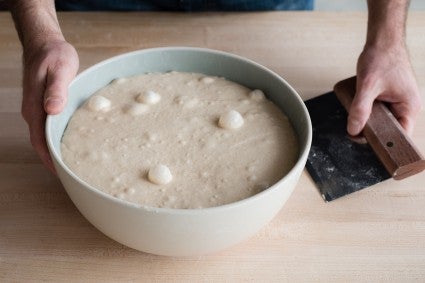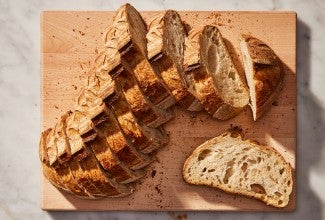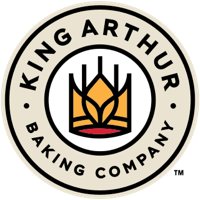Ask the Bread Coach: My dough isn’t rising — what now?
The best solution is patience. But if you don’t have that, there are some other tricks.


In the two years that I’ve been working with my bread coach (aka Martin Philip), one question has plagued me more than any other: In my cold, drafty house, how can I get my dough to rise faster?
My frigid fingers have typed that question in a text message to the coach countless times, but I’ve always been reluctant to press send. I figured that there wasn't actually a problem with my dough. The problem was my (lack of) patience.
Turns out I was right. “Home bakers chronically underferment their bread,” Martin told me when I finally confessed my problem. For bakers like me, he said, patience really is a problem: We get sick of waiting and put our breads into the oven before they’re truly ready. The result is squat loaves and dense crumbs — still edible, but nowhere near ideal.
Can my bread coach make me a more patient person? (Can anyone?) Nope. But the coach did have some other workarounds for slow-rising dough.
David Tamarkin: When people come to you and say their dough isn’t rising, what’s your first piece of advice?
Martin Philip: First and foremost, I ask if and how they’re measuring their ingredients. And when I say “measure ingredients,” I mean measuring temperatures as well. What was your water temperature? What is the dough’s temperature? Measuring temperature is as important as measuring the amount of salt or the amount of yeast.
Two, what's the quality of your leaveners? Are you using a sourdough culture that’s in poor health? Are you using the right kind of yeast?
If you’ve controlled temperature and you’ve controlled leavening, you should be on a proper course. The only other thing you want to think about is the ambient temperature of the room. If it’s cold in your house, your dough will be sluggish, so you’ll want to find a warm spot for it to rise.
When you control for temperature — the temperature of the dough and of the room — you can get your dough into the Goldilocks zone for optimal fermentation.
DT: Taking the temperature of the ingredients and the room is all in service of achieving Desired Dough Temperature (DDT). But a lot of recipes don’t give you a DDT to aim for. Is there a general range people can look for that will put them in that “Goldilocks zone” for rising dough?
MP: There are a lot of variables, but in broad terms we’re aiming for between 75 and 80 degrees. That’s our sweet spot.
DT: And that’s true for a sourdough country loaf, and challah, and a white sandwich bread …?
MP: Yup. We can get a lot more persnickety about it, but if you aim for bread dough in the 75 to 80 degree zone, you'll be off to a good start.

DT: Let’s say I’ve mixed my dough, taken it’s temperature with an instant-read thermometer, and discovered it’s running cool — 70 degrees. My house is pretty cool — 67 degrees.
MP: Unfortunately, dough likes an ambient temp that is higher than room temp. If your room is between 70 and 72 degrees, you should be good, as long as your dough is in that 75 to 80 degree range. But if you have a cool dough, a cool room isn’t going to do anything to warm it up. You’ll have to make some adjustments: You’re either going to reduce fermentation in the case of a warm dough, or, in the case of a cool dough, extend fermentation.
DT: In other words, if the dough is sluggish and cool, I should just let it rise for longer.
MP: Exactly. If you can’t control for temperature, you can control for time. So you may want to increase the length of bulk fermentation by 25% to 50% of the time listed in the recipe.
DT: Let’s say I have somewhere to be, or I’m just feeling impatient. Is there anything I can do to speed up fermentation?
MP: Yes. You can do everything possible to increase the temperature of the dough by adjusting ambient conditions. Problem is, it’s very hard to get warmth into a dough. It’s much easier to cool a dough down than to warm it up. But if you have the Brod & Taylor Proofing Box, that’s a pretty good way to warm it up.
DT: Everybody loves that thing! What temperature do you set it at to speed up a sluggish dough?
MP: 80, 85 degrees. It’s got to be like a warm embrace, you know? Bakeries run proofing boxes at around 85.
But almost as good as a proofing box is taking a Mason jar filled halfway up with water, microwaving it for two minutes, then putting your bowl of dough into the microwave with the jar to rise.
The other thing you can do is place your lidded container or bowl of dough into a second, larger bowl of warm water. Water that’s, say, 105 to 120 degrees. Just make sure your dough is sealed water-tight!

DT: What about using the oven? People often recommend putting dough in there with the oven light on …
MP: I think the oven causes more problems than it’s worth. Because somebody is likely to turn that oven on. So yeah, I guess you can use the oven. But you have to be careful. Put a sign on it that says “Don’t touch!”
DT: No thanks, I think you’ve successfully scared me off that one. What about heating pads?
MP: Heating pads work. Or if you’re a gardener and have one of those heated seed mats for germination, that will work too.
Or you can simply get your Thermapen out and start walking around your house, searching for the warm spots. If you’ve got a refrigerator with cabinets above it, that’s often a warm place for rising dough.
But with all of these options you have to be careful that you don’t get the dough too warm. Otherwise you’ll end up with a dough that’s overproofed.
DT: Which is another fear of home bakers. How can they avoid that?
MP: If you keep your dough at the correct temperature and you check it as it rises, you’re likely to catch it before it overproofs. But if, despite your best intentions, you do overproof your loaf, you’ve learned something! And that's progress in itself. The only way to get better as a baker is through repetition. You’ve got to get some experience. You’ve got to get some reps. But really, I think bakers tend to underproof more than they overproof. [Ed. note: if you do end up overproofing your dough, here are some ways to save it.]
DT: What if I’m an hour into bulk fermentation and my dough isn't rising at all? Can I just, like, knead in some more yeast?
MP: I mean, you can, but that opens a whole other can of worms. Rather than do that, I would look to extending fermentation if your dough isn’t rising quickly. Or just go ahead and bake your bread. Accept that you did the best you could that day, and try again tomorrow.
DT: Ouch.
MP: Hey, it happens. But when you do come back tomorrow, knowing that your house is cold, aim high. Aim for a dough temp of 82, 83 degrees, which might mean that you start with hotter water at the outset, and employ some of the other tricks, like a heating pad or the microwave move, because you know the dough temperature is going to drop quickly in your cold house if you don’t do something to maintain it. I guess that’s my main tip for this entire problem. Aim high! Good advice for life, but particularly for bread.
Cover photo by Mark Weinberg; food styling by Liz Neily.



November 27, 2024 at 9:08pm
My husband attempted to make homemade bread today. It was slow to rise. We live in SW Florida now. When making homemade bread up in our former state of WI., rising dough was never an issue.
Does sea level play a factor in how fast bread dough will rise? Just curious.
December 1, 2024 at 3:12pm
In reply to My husband attempted to make… by Kathy Elack (not verified)
Hi Kathy. Elevation certainly can play a part in how yeasted doughs rise. The higher the elevation, the lower the air pressure, so rising doughs will often move faster. That is not the only thing that can affect rise though. Temperature (both of the dough and the surrounding kitchen area), hydration (how much moisture is in the dough and/or the air) and gluten development can also affect the rise. If your doughs are slow to rise...not to worry! You can simply place the dough in a warmer spot to help increase the activity of the dough or simply give it more time. Once it reaches the appropriate level of growth, you can go ahead and bake as directed.
July 17, 2024 at 7:35pm
Try putting your dough in an insulated picnic box - AKA chilli-bin or esky - with a hot water bottle. It works great for my croissants.
July 18, 2024 at 9:42am
In reply to Try putting your dough in an… by Larry Post (not verified)
Love this idea Larry! My kitchen is too hot to try it now, but this winter I'll definitely have a chance to give it a go.
April 8, 2024 at 7:24pm
I’ve had a sourdough loaf recipe for years. The recipe uses a 55/45 ratio of whole wheat and bread flour. I decided to make two adjustments to make the bread chewier. First I changed the ratio to 50/50 and I also let the dough rest in my fridge overnight before bulk fermentation. The first time it tried this, I overproofed the load and it collapsed. The second time I caught it jus before it collapsed, but it wasn’t as high as the original recipe. How do I change the recipe to make it rise higher, with out it collapsing?
April 12, 2024 at 11:42am
In reply to I’ve had a sourdough loaf… by Tomas (not verified)
Hi Tomas, this sounds like more of a timing issue than a recipe/formula problem, since increasing the amount of bread flour relative to whole wheat flour shouldn't have contributed to your bread collapsing or rising less than it has previously. Perhaps refrigerating the dough before the bulk fermentation has made it more difficult for you to read the dough and determine the correct time for baking it, or the timing is just trickier when you refrigerate it in this way. With sourdough breads it's generally helpful to allow some time for the bulk fermentation to occur at room temperature prior to refrigeration, or the dough may chill down and become relatively dormant during this period. You might try 2-3 hours of bulk fermentation at room temperature prior to sticking your dough in the fridge (our No-Knead Sourdough Bread recipe follows this timeline) and see if that improves your results, although keep in mind that the time after refrigeration should be shorter when you employ this method.
February 20, 2024 at 10:25am
When cut a bread dough recipe in half do you cut the amount of yeast in half as well? I tried it yesterday and the dough took a really long time to raise even though I kept in the same conditions as when I make a full recipe. {A full recipe makes 4 loves). I am wondering if I should use a little more yeast next time.
February 29, 2024 at 4:22pm
In reply to When cut a bread dough… by LuAnn (not verified)
While cutting the yeast in half doesn't follow baker's percentages precisely we generally recommend doing this for most home recipes as the difference is so minimal. If you find that your dough is slowing down with the lower amount of yeast then adding a bit more, or extending rise times are both an option for your next loaves. It just depends on your priorities and expectations as you approach your next bake LuAnn!
February 7, 2024 at 2:15pm
I cannot get my bread to rise enough. I've been using the recipie from the King Arthur baking school cookbook, I measue ingredients by weight, check the temperature of everything, use the equation to get my water temperature, and proof in a proofing box I got for xmas with with box set at 80 degrees. I have replaced the ingredients I used, proofed for varying lengths of time, i have even over proofed and even with the extra time it hadnt risen enough before I put it in the oven but I figured it was overproofed at that point, i had proofed for more than double the time the recipe stated (and it collapsed some in the oven). My dough has never doubled in size no matter what I do. Should I be adding more yeast than the recipe states? Knead longer even though it seems smooth and slightly tacky when I finish kneading to help build gluten more?Is there something else I should be trying?
February 10, 2024 at 3:00pm
In reply to I cannot get my bread to… by K (not verified)
Hi K, we're sorry to hear you're having so much trouble getting your bread to rise! What recipe are you making from the Baking School Cookbook? Are you using our flours, or another brand of flour? This could impact the recipe, since other brands of flour don't tend to be as high in protein as our flour, which means they won't develop as much gluten and also won't absorb as much water. This can end up resulting in a dough that is wetter and doesn't rise as well. For more help troubleshooting, please don't hesitate to contact our Baker's Hotline. We're here M-F from 9am-9pm EST and Saturday and Sunday from 9am-5pm EST, and the number to call is 855-371-BAKE (2253).
Pagination